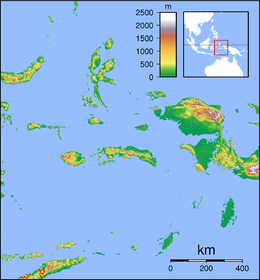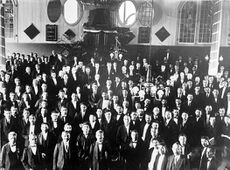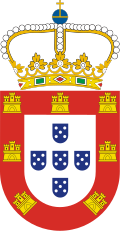جزيرة أمبون
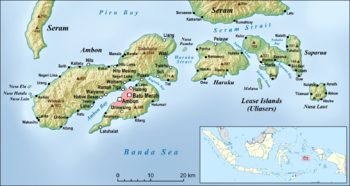 أمبون (يسار) وLease Islands | |
| الجغرافيا | |
|---|---|
| الموقع | جنوب شرق آسيا |
| الإحداثيات | 3°38′17″S 128°07′02″E / 3.63806°S 128.11722°E |
| الأرخبيل | جزر الملوك |
| المساحة | 743.37 km2 (287.02 sq mi) |
| أعلى منسوب | 1,225 m (4٬019 ft) |
| أعلى نقطة | Mount Salahutu |
| الإدارة | |
Indonesia | |
| المحافظة | Maluku |
| Largest settlement | Ambon |
| السكان | |
| التعداد | 475,357 (تعداد 2020) |
| الكثافة السكانية | 639٫46 /km2 (1٬656٫19 /sq mi) |
| اللغات | Ambonese Malay |
| الجماعات العرقية | Ambonese |
| معلومات إضافية | |
| Time zone | |
جزيرة أمبون أحد جزر الملوك في أرخبيل الملايو، وهي تتبع مقاطعة مالوكو في إندونيسيا.
الجزيرة تبلغ مساحتها 775 كم²، ذات طبيعة جبلية وتربة خصبة.
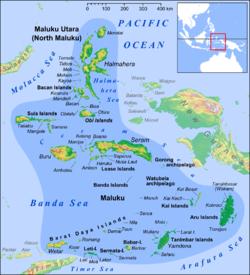 جزيرة أمبون في وسط جزر الملوك |
مدينة أمبون عاصمة مقاطعة مقاطعة مالوكو، يبلغ سكانها370931 نسمة، وهي تحتوي ميناء ومطار، وتقع فيها بعض الجامعات مثل:
- جامعة باتيمورا
- الجامعة المفتوحة
- جامعة دار السلام
- جامعة كريستين في مالوكو الإندونيسية
الديمغرافيا
The Ambonese are of mixed Malay-Papuan origin. They are mostly Christians or Muslims. The predominant language of the island is Ambonese Malay, also called Ambonese. It developed as the trade language of central Maluku and is spoken elsewhere in Maluku as a second language. The old creole trade language called Portugis has died out. Bilingualism in Indonesian is high around Ambon City. There have been strong religious tensions on the island between Muslims and Christians[1] and ethnic tensions between indigenous Ambonese and migrants from Sulawesi, primarily Butonese, Bugis and Makassarese migrants.
التاريخ
العصر الاستعماري
In 1512, the Portuguese were the first Europeans to land in Ambon, and it became the new centre for Portuguese activities in Maluku following their expulsion from Ternate.[2] The Portuguese, however, were regularly attacked by native Muslims on the island's northern coast, in particular Hitu, which had trading and religious links with major port cities on Java's north coast. They established a factory in 1521 but did not obtain peaceable possession of it until 1580. Indeed, the Portuguese never managed to control the local trade in spices and failed in attempts to establish their authority over the Banda Islands, the nearby centre of nutmeg production. The creole trade language Portugis, however, was spoken well into the 19th century, and many families still have Portuguese names and claim Portuguese ancestry, for example Muskita and De Fretes.[3]

The Dutch dispossessed the Portuguese in 1605, when Steven van der Hagen took over the fort without a single shot. Ambon was the headquarters of the Dutch East India Company (VOC) from 1610 to 1619 until the founding of Batavia (now Jakarta) by the Dutch.[5] About 1615 the English formed a settlement on the island at Cambello, which they retained until 1623, when the Dutch destroyed it. Frightful tortures inflicted on its unfortunate inhabitants were connected with its destruction. In 1654, after many fruitless negotiations, Oliver Cromwell compelled the United Provinces to give the sum of 300,000 gulden, as compensation to the descendants of those who suffered in the "Ambon Massacre", together with Manhattan.[6] In 1673, the poet John Dryden produced his tragedy Amboyna; or the Cruelties of the Dutch to the English Merchants. The British, under Admiral Peter Rainier, captured Ambon in 1796, but they restored it to the Dutch at the Peace of Amiens in 1802. They retook the island in 1810 but once more restored it to the Dutch in 1814. Ambon used to be the world center of clove production; until the nineteenth century, the Dutch prohibited the rearing of the clove tree on all the other islands subject to their rule, in order to secure the monopoly to Ambon.[7]
Under the Dutch Empire, Ambon city was the seat of the Dutch resident and military commander of the Moluccas. The town was protected by Fort Victoria, and a 1902 Encyclopædia characterized it as "a clean little town with wide streets, well planted".[8] The population was divided into two classes: orang burger or citizens and orang negri or villagers, the former being a class of native origin enjoying certain privileges conferred on their ancestors by the old Dutch East India Company. There were also, besides the Dutch, some Arabs, Chinese and a few Portuguese settlers.
Ambon city was the site of a major Dutch military base that Imperial Japanese forces captured from Allied forces in the World War II Battle of Ambon in 1942. The battle was followed by the summary execution of more than 300 Allied prisoners of war in the Laha massacre.
A large Far East prisoner of war camp was situated in the north near Liang. This was made up of British men of the 77th HAA, 3rd Kings Own Hussars and some RAF volunteers. Approximately 1,000 men arrived in April 1943 and were marched from Ambon town over two days without food or water (see 1000 men of Liang to follow).
The FEPOWs built the camp including a water pipeline. They were ordered to build an airfield and runway alongside the beach and cleared coconut trees for the task. They did all they could to sabotage construction.
Conditions were horrendous and many men died due to disease, starvation and ill treatment by the Japanese. Many men also suffered blindness due to working chipping at the coral.
انظر أيضا
الهامش
- ^ Mardai, Gadis (30 January 1999). "Ambon rioting leaves 100 dead in Indonesia". World Socialist Website. Archived from the original on 15 December 2006. Retrieved 10 January 2007.
- ^ Ricklefs 1991, p. 25.
- ^ Sneddon, James (2003). The Indonesian language: its history and role in modern society. Sydney: University of New South Wales Press. p. 80. ISBN 9780868405988.
- ^ "Maluku". www.hubert-herald.nl.
- ^ Ricklefs 1991, p. 28.
- ^ Milton, Giles (2000). Nathaniel's Nutmeg: How one man's courage changed the course of history. Sceptre. p. not cited. ISBN 0-374-21936-2.
- ^ Corn, Charles (1998). The Scents of Eden: A Narrative of the Spice Trade. New York: Kodansha Amer Inc. ISBN 1568362021.
- ^ Encyclopædia Britannica. Article "Amboyna" island and town: The Times, London. 1902. p. 351.
المصادر
- Conboy, Kenneth; Morrison, James (1999). Feet to the Fire CIA Covert Operations in Indonesia, 1957–1958. Annapolis: Naval Institute Press. ISBN 1-55750-193-9.
{{cite book}}: Invalid|ref=harv(help) - Ricklefs, M.C. (1991). A History of Modern Indonesia Since c.1300 (2nd ed.). London: Macmillan. pp. 25, 28. ISBN 0-333-57689-6.
{{cite book}}: Invalid|ref=harv(help)
للاستزادة
- Kahin, Audrey R; Kahin, George McT (1997) [1995]. Subversion as Foreign Policy The Secret Eisenhower and Dulles Debacle in Indonesia. Seattle and London: University of Washington Press. ISBN 0-295-97618-7.
{{cite book}}: Invalid|ref=harv(help)
